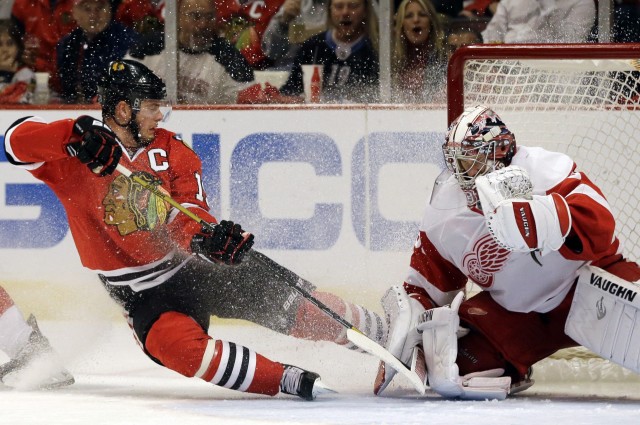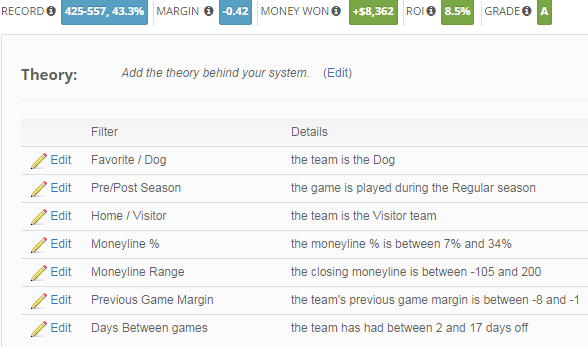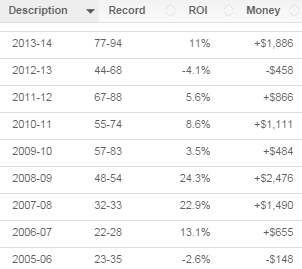
2014-15 NHL Betting Against the Public Report
The NHL season begins on October 8th with the Montreal Canadiens travelling to face the Toronto Maple Leafs, and we want to make sure that bettors are ready to hit the ground running. Before the start of every season, we post a series of Betting Against the Public articles where we highlight the sweet spots for contrarian betting. These systems typically highlight how sharp bettors can take advantage of public perception by wagering on teams that are being ignored by the betting public.
These systems are particularly interesting in moneyline sports like hockey and baseball because you don’t necessarily need to win at the 52.38% threshold that spread bettors need to hit to overcome the typical -110 juice. In fact, the system featured in our 2014 MLB Betting Against the Public report has a winning percentage of just 45.2% but has earned an incredible +112.45 units (16.2% return on investment) since the start of the 2005 season.
To create our 2014-15 NHL Betting Against the Public system, we must first utilize our Bet Labs software which allows subscribers to create data-driven betting systems from their choice of more than 200 unique filters across seven major sports leagues.
We’ve been long aware that baseball is the only sport in which the home team is undervalued, and when you think about it, that makes all the sense in the world. People tend to believe that visitors will be thrown off their game by hostile crowds, but the true value of that edge tends to be overblown. Baseball is the only sport where there is a tangible advantage for the home team — getting the last at-bats and having the ability for general managers to acquire talent that exploits the unique dimensions of their home ballpark.
With that in mind, we compared the record of home teams (-2.7% ROI) and road teams (-0.6%) which quickly confirmed that visitors are being undervalued by bettors. Having our initial expectation confirmed, we wanted to see how visitors fared when we used our proprietary public betting data to examine the success of betting against the public when focusing on road teams.
The table below displays how visiting teams have performed when they are not being backed by public bettors.
As you can see, our sweet spot for NHL contrarian betting comes when visitors are receiving less than 35% of moneyline bets. When we focus on underdogs fitting these criteria, there are only a few past matches omitted and we are left with an 1135-1822 record (+69.82 units, 2.4% ROI).
Our past research indicates that large underdogs typically don’t perform well, so our goal was to adjust our moneyline range to weed out these massive dogs. Part of the reasoning behind this is that sportsbooks tend to increase from a 10 cent juice to a 15 cent juice on huge moneyline dogs which sucks out some of the value. The table below displays how road dogs receiving less than 35% of public bets have performed as we gradually shrink our moneyline range.
What’s readily apparent from this data is that we’re able to continually improve our ROI by focusing small dogs, however, we prefer betting systems with larger sample sizes as it’s a better indicator of a system’s true edge and also because it reduces the risk of overfitting your system. For that reason, we’re choosing to focus on teams with a moneyline no larger than +200 even though the highest ROI is on underdogs of +150 or less.
It’s also important to note that betting against the public is only one part of our overall contrarian philosophy. One of the other important adages we constantly preach is simple enough: buy on bad news and sell on good. This may seem counter-intuitive as most bettors don’t want to bet on a team that has been performing poorly recently. However, the public’s tendency to overreact to small sample sizes can create artificial value that sharp bettors can exploit.
Knowing this information we set the “previous game margin” filter between -1 and -8 which allows us to focus exclusively on teams who lost their previous game. This is a classic example of buying on bad news and this simple addition improves our system to 534-741 with +70.76 units won and a 5.6% ROI. While this results in a loss of nearly 25 units, it also leads to a 33% improvement to our expected returns (from 4.2% to 5.6%).
Although it can’t be characterized as a “contrarian” viewpoint, one edge that we’ve consistently observed around all six major US sports is that teams tend to perform better when they are well rested. For that reason we utilized the “days between games” filter and eliminated all teams playing on the second night of a back-to-back by making sure there were at least two days between games.
This addition improved our overall units earned from +70.76 to +83.62 while lowering the number of past matches from 1275 to 982. By increasing our units won by 12.86 units and decreasing our past matches by 293 games, we’re able to improve our ROI to 8.5%. The screenshot below displays how this betting system would look within Bet Labs.
Another key factor in developing a winning betting system is consistent year-to-year returns and, with the exception of 2005-06 (-1.48 units) and the lockout shortened 2012-13 season (-4.58 season) this system has been profitable every year.
We offer a 6-day Bet Labs trial< for anybody interested in creating their own winning NHL betting systems, but Pro customers have full access to our Best Bets and Bet Signals along with real-time odds, public betting trends and much more. We’ve also introduced a new free NHL odds page where bettors can access odds, injuries, futures and other valuable information. Current Bet Labs customers can also copy this system from the Think Tank to receive all current game matches via e-mail or text message.
Have any questions for the staff at Sports Insights? Utilize our live chat to speak with a customer service representative or e-mail us at help@sportsinsights.com.
6/6/16 Update: This system went 54-86 (-3.09 units) during the 2014-15 season and 73-99 (+6.89 units) during the 2015-16 season. All-time this system has gone 540-730 (+82.61 units) during the regular season and 38-48 (+11.59 units) during the NHL Playoffs.



Austin
10/06/2014 at 6:11 pmHas anyone looked at this same system but using the +1.5 puck line for the dogs? Seems like it could be similarly profitable–possibly more wins, though they would be for smaller $. Still, I would think there could be a little less volatility
David Solar
10/07/2014 at 10:00 amThis would still be profitable if utilized as a puckline system (+41.37 units won), however, our return on investment (ROI) is cut in half.
Austin
10/07/2014 at 2:26 pmThanks for the info!
Brad
10/15/2014 at 1:32 pmIn the past results of your Contrarian plays for the NHL (under the “Bet Signals” tab of your main screen for paid users), it shows losses in the years of 2008-09, 2010-11 and 2012-13. In the chart in your article, the only years you had losses was 2012-13. Can you explain that discrepancy and what exact criteria do you use when you release an official Contrarian play?
Also, I’m not sold on your reasoning for MLB having the best home field (betting) advantage. In my own mind, park size and batting last do not compare to a crowd going bonkers and confusing the heck out of a visiting offense. Could you show proof by outlining the ROI’s for each sport’s home teams for the last 10 years (ATS for football and basketball and moneyline for hockey and basketball). If you use a dimeline in baseball, you have to use it in hockey and also -105 for football and basketball spreads. We want to compare apples to apples. My gut feeling is these ROI’s are pretty similar, with college home teams probably being the best to bet. I believe this because college sports have a unique entity called the top 25, and win margin plays a role in this. Also, from what I’ve seen, the crowd makes more noise in college sports vs. pro.
David Solar
10/15/2014 at 1:57 pmHistorically our contrarian plays have simply been the most lopsided bet games according to the moneyline percentage, however, as we’ve developed new systems and discovered various historically profitable trends our criteria has changed. In fact, our contrarian plays (formerly square plays) have always differed from our betting against the public systems.
As far as the home/away splits, it’s that type of public perception that makes home field advantage overrated in sports with loud, passionate fans like basketball, football and hockey. It’s not necessarily that home field advantage isn’t valuable in those sports, it’s that home field advantage isn’t worth as many points on the spread as bettors tend to believe. NFL home teams have an ROI of -4.3%. NBA home teams have an ROI of -4.8%. MLB home teams have an ROI of just -1.3% which is far better than MLB visitors.
Brad
10/15/2014 at 4:20 pmThanks for the response. So NCAA football and NCAA basketball home teams are just as bad?
Maybe it is the perception that giving up a point is much easier to swallow than putting up more money to win whatever you want to win. As an example, when a football line moves from pickem to 2, the bettor says “that’s not even a field goal” and takes the home team without much thought. However, in a similar baseball example, when the line moves from even to -140, that might be a seemingly bigger deal and the bettor might not want to bet the favorite any more.
So, I guess what I’m saying is, perhaps in baseball the inherent betting nature of the sport is what makes it seem like home field advantage (betting wise) is greater (moneyline vs. ATS). How bad are the ROI’s betting the moneyline for home teams in the non-baseball sports?
David Solar
10/16/2014 at 2:07 pmIn College Football visitors have a -1.3% ROI versus a -3.7% ROI for home teams. When we focus solely on conference games visitors ROI jumped to +0.1% versus a -4.8% ROI for home teams in conference games. I think the reasoning behind this is that road teams aren’t as affected by the hometown crowd as bettors like to believe and bettors think that crowd noise has no affect in baseball betting. However, the tangible benefits for MLB home teams (like having the final at-bat) are actually undervalued by bettors. Hockey, like baseball, is also a moneyline sport, but visitors are still undervalued in the NHL.
Chris
10/15/2014 at 5:19 pmWasn’t there 3 plays for this system last night? Caro/EDM and Dallas? All fit into the system as I understood it or did the Caro/EDM not qualify. Thanks in advance for clarifying.
David Solar
10/16/2014 at 1:58 pmThere was only one play on Tuesday (10/14) and it was on Calgary (+143) against Nashville which ended as a 3-2 victory. I’m not sure which other games you’re referring to because Carolina has not played Edmonton yet and they were -180 favorites on Tuesday against Buffalo.
chris
10/16/2014 at 3:13 pmYes sir that was suppose to be Calgary. I also had Dallas and Edm on 10/14. Both teams dogs (dallas moved by gametime) Both teams off losses, both teams on 2 days rest. Both fitting in between the -105 +200 range. Both not the pub side from what I can see. (I’m sure I’m missing something) I appreciate the response. Let me know what I’m missing.
Thanks David.
David Solar
10/16/2014 at 4:20 pmDallas received 51% of moneyline bets while Edmonton closed as a +225 underdog which puts them outside our ideal moneyline range.
chris
10/16/2014 at 4:31 pmThanks David. Appreciate the response.
James
10/16/2014 at 8:55 pmQuestion regarding the “off days” say a team has a game tonite Thursday the 16th. Would you consider a game on the 18th to be two days rest? Just want to make sure I’m on the same page. Thanks for all the articles you guys post for us!
David Solar
10/16/2014 at 9:00 pmExactly. The filter is for days between games, so 0 would indicate a doubleheader, 1 would be the previous day, and 2 would mean the team had a full off day.
James
10/16/2014 at 9:31 pmThanks for the quick reply David. Appreciate all you guys do.
chris
10/17/2014 at 11:26 amThanks for clarifying the days between, I thought it was two days off between games. Understand now. Thanks.
Ben
11/06/2014 at 3:44 pmDo you include overtime losses as a loss? How about shootout losses?
David Solar
11/06/2014 at 3:57 pmThese are all two-way lines so overtime and shootout losses are still considered losses.
Tom
11/18/2014 at 5:03 pmLast year you guys had the total filter of 5.5 to 7 for this analysis, but not this year. Is the total not significant anymore?
David Solar
11/19/2014 at 8:35 amIt’s still more profitable to bet on underdogs in games with high totals and by focusing on closing totals of 5.5+ our units won drops by 11 but our ROI improves by 0.9%.
Will
12/03/2014 at 11:47 pmI like this system a lot but it has been so wretched of late and i can’t figure out why, i do not want to quit on it and refuse to bet favorites and lay juice but are there any other more effective contrarian systems with more consistency or is this system that streaky where you can lose 10 in a row then it turns around?
Joel
12/30/2014 at 8:30 amHave you tried betting on underdog +0.5 in regulation time (in some bookies it is under the “double chance” option, taking the underdog win or draw)? The odds would be better than the +1.5 puck line but worse than money line. What is the ROI?
David Solar
12/30/2014 at 11:13 amAll of the archived NHL data in Bet Labs utilizes the 2-way lines (win/loss) from Pinnacle and unfortunately we do not track the 3-way lines (win/loss/draw) at this time.
Joel
12/30/2014 at 5:05 pmPinnacle has a market called “NHL Regulation Time”, where you can bet on the -0.5/+0.5 spread line (i.e. favorite win in reg. and underdog win or draw in reg.) and ML (i.e. draw no bet) in regulation time. The odds of underdog +0.5 in Reg. is normally around 75%-80% of the odds of underdog ML. Would it be possible to check the Win/Loss record for all Underdog +0.5 in reg. bets so that we can have a rough estimate of the ROI?
David Solar
12/31/2014 at 9:25 amAs I said earlier, we just track the 2-way lines so we do not have that data archived. Unfortunately we can not check the record for your requested system.
Brian
01/01/2015 at 6:42 pmDavid – your link to copy from think tank just refreshes the article. Can you adjust?
Brian
01/01/2015 at 6:44 pmNevermind – I found the system under think tank. Thanks.
Anonymous
06/16/2015 at 8:45 amVery good information. Lucky me I discovered your website by accident (stumbleupon). I’ve book marked it for later!